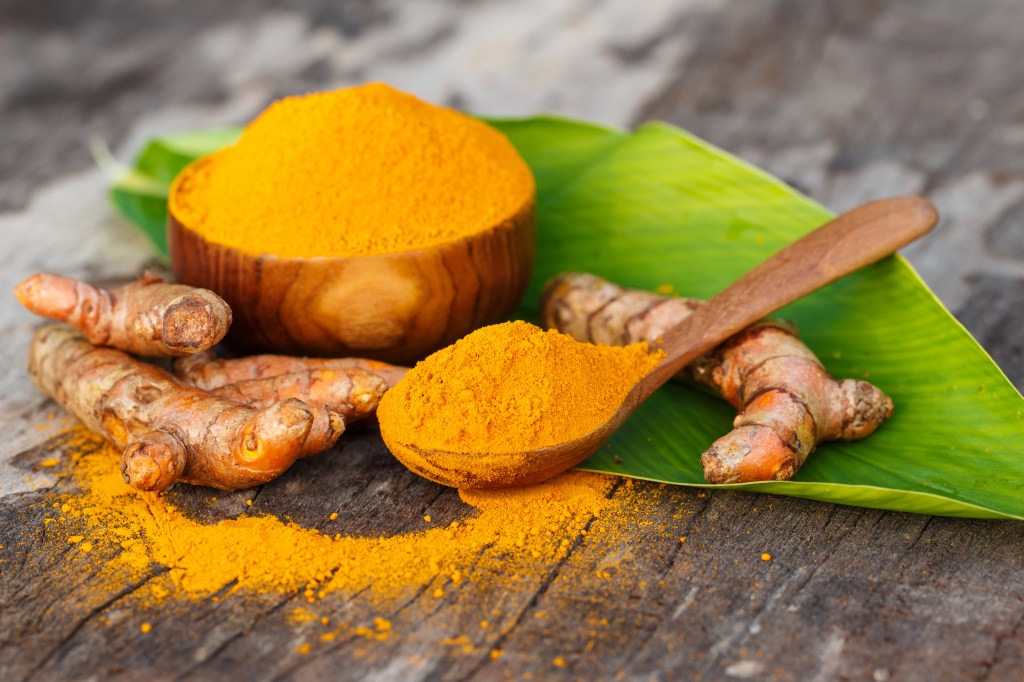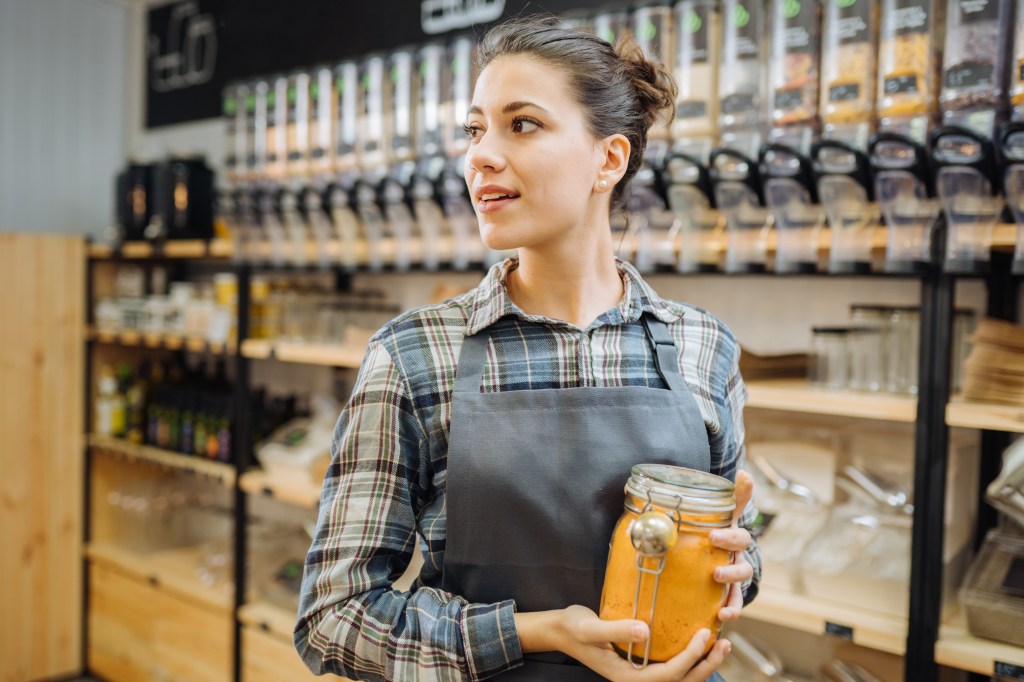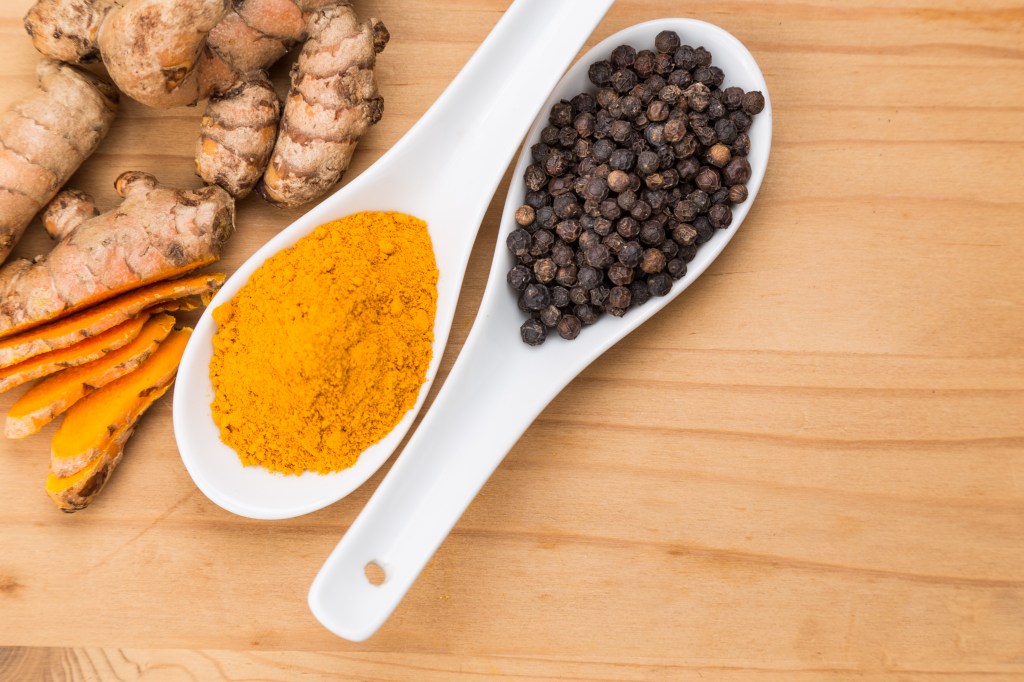At a glance
Cooking with turmeric enhances the flavor, color, and nutritional value of meals while supporting digestive, immune, and brain health. This vibrant spice, rich in curcumin, is best absorbed when paired with healthy fats and black pepper. From golden milk to savory dishes, such as butter chicken or turmeric soup, it offers a simple way to enhance wellness through everyday cooking.
Cooking with turmeric is a simple yet flavorful way to elevate an ordinary meal into a nutritional powerhouse.
This aromatic spice adds a distinctive earthy flavor and a vibrant golden color to your dishes, making them both appetizing and nutritious.
Learn about the impressive health benefits of cooking with turmeric and discover five easy recipes you can make at home.

What is turmeric?
Turmeric is an ancient spice that has been cherished for thousands of years, especially in traditional Chinese medicine, Indian Ayurveda, and Southeast Asian cuisine. Its value lies not only in its distinctive flavor but also in its medicinal benefits.
This aromatic spice is a key ingredient in many staple meals, including curries, soups, and rice dishes. You can find turmeric in grocery stores, often located near fresh ginger and garlic, or in the spice aisle as dried turmeric powder.
A standout feature of turmeric is its high curcuminoid content, with curcumin being the most abundant and well-studied.
Curcumin is a natural compound known for its powerful antioxidant and anti-inflammatory properties, which can help contribute to overall wellness.
Turmeric is classified as a rhizome, an underground root-like stem similar to ginger. Fresh turmeric root has a vibrant orange color, indicating its high concentrations of nutritious phytonutrient pigments.
The striking color of turmeric also makes it a popular natural dye for foods and textiles. As a non-toxic and environmentally friendly option, turmeric offers an excellent alternative for those looking to avoid synthetic ingredients.
Watch the video to learn why turmeric is the most potent natural remedy in the world.
3 health benefits of cooking with turmeric
In addition to adding flavor and color, turmeric’s high concentrations of active compounds support various aspects of health, including digestion, immunity, and brain function.
Here are three reasons why you should regularly add turmeric to your meal plan.
1. Enhances digestive health
Turmeric has long been used as a holistic remedy for digestive wellness.
Curcumin has been shown to support the gut lining, promote microbial balance, and help maintain balanced inflammatory responses in the digestive tract.
Turmeric intake is generally associated with improved digestive comfort and may serve as a natural, food-based option to help support gut health.

2. Promotes strong immune defenses
Research published in Scientific Reports found that curcumin can interact with enzymes that regulate reactive oxygen species (ROS) inside cells.
ROS are unstable oxygen molecules that, in controlled amounts, support cell signaling and immune defense, but in excess, can contribute to cellular dysfunction.
By modulating ROS-regulating enzymes, curcumin may promote normal cellular function, which is a critical factor in maintaining strong immune defenses and overall health.
3. Supports brain function
Curcumin may support healthy brain function and help regulate emotional balance.
A study published in Neuroscience Letters found that curcumin helped restore healthy levels of brain-derived neurotrophic factor (BDNF), a crucial protein needed for neural plasticity, memory, learning, and mood regulation.
While these findings have only been studied in animals, they offer valuable insight into curcumin’s potential to protect brain cells and support long-term cognitive health.

Tips for using turmeric
With a few easy techniques, you can maximize turmeric’s taste, health benefits, and absorption.
How to choose the best turmeric
Depending on your preference and availability, you can use turmeric in either its fresh root form or as a fine powder.
Look for fresh turmeric in the produce section and opt for organic options if possible to avoid pesticide exposure. Select roots that are firm, brightly colored, and free from mold or soft spots.
If buying powdered turmeric, check the label to ensure it’s 100 percent turmeric without added dyes or fillers, which are sometimes used to enhance color or reduce cost.
How to store turmeric
To store fresh turmeric, wash it thoroughly and allow it to dry completely. Once dry, wrap it loosely in a dry paper towel, then place it in a plastic bag or container inside the crisper drawer of your refrigerator. If kept dry, turmeric root can remain fresh for several weeks.
For prolonged storage of up to six months, grate the root and freeze portions in ice cube trays with water or coconut milk, making it easy to pop a cube into your recipes whenever you need it.
Ground turmeric is best stored in an airtight jar placed in a cool, dark cupboard away from moisture and direct sunlight. Properly stored, turmeric powder can retain its potency for up to three years.

Combine with healthy fats and black pepper
“Curcumin, the active compound in turmeric, isn’t easily absorbed on its own,” explains Dr. Berg. “But combining it with healthy fats and a bit of black or white pepper significantly increases its bioavailability.”
As a fat-soluble compound, curcumin requires the presence of fats such as cold-pressed olive oil, coconut oil, ghee, or butter for optimal absorption.
A pinch of ground white or black pepper can also help enhance bioavailability due to its piperine content–the chemical compound responsible for its signature spicy flavor profile.
In addition, gently heating turmeric may enhance the solubility of several beneficial compounds, including its curcuminoids.
Interestingly, this result is dependent on the cooking method. According to research published in Foods, boiling turmeric for ten minutes resulted in a substantial increase in both curcuminoid content and antioxidant potential.
However, the same study found that microwave-heating turmeric for longer than one minute caused a sharp decline in curcuminoid levels, resulting in significantly less active compounds than boiling or frying.
For best results, traditional stovetop methods, such as boiling or sautéing, appear most effective at preserving and even amplifying turmeric’s beneficial properties.

Healthy ways to cook with turmeric
Turmeric is an incredibly versatile ingredient and easy to incorporate into both savory dishes and soothing beverages.
Here are five delicious and nourishing ways to incorporate turmeric.
1. Lemon Ginger Turmeric Immune Drink
One of the easiest turmeric recipes is this Lemon Ginger Turmeric Immune Drink, which combines fresh ginger, turmeric, lemon, garlic, apple cider vinegar, Manuka honey, and extra virgin olive oil.
This simple recipe uses whole-food-based ingredients and fresh herbs to create a powerful wellness shot that can be taken daily or as needed. It’s an excellent way to add turmeric into your routine while supporting your immune system and enhancing overall wellness.
You can also enjoy this drink warm by adding a small amount of hot water, creating a comforting turmeric tea.
2. Golden milk
Golden milk is a traditional turmeric-based drink made with coconut milk, ginger, cinnamon, and a touch of black pepper.
This warming beverage not only supports comfort and relaxation but also delivers turmeric in a concentrated and highly absorbable form.
Watch the video below to learn how to make golden milk at home.
3. Keto Indian Butter Chicken
Keto Indian Butter Chicken is a sugar-free alternative to the traditional Indian version.
This classic dish features a rich blend of yogurt, butter, and warming spices, including turmeric, garam masala, and cumin. The inclusion of healthy fats and black pepper makes it an ideal way to enjoy turmeric’s benefits while staying low-carb.
Keto Indian Butter Chicken pairs perfectly with cauliflower rice and keto naan, creating a hearty, flavorful, and satisfying meal without spiking your blood sugar levels.
4. Keto-Friendly Coconut Turmeric Soup
Keto-Friendly Creamy Coconut Turmeric Soup features carrots, coconut milk, ginger, and turmeric, blended into a smooth and creamy dish that’s perfect for chilly days.
The coconut milk adds a healthy source of fat, while the aromatic combination of turmeric, clove, and ginger creates a delicious and nutrient-rich soup.
5. Turmeric Tofu Ketogenic Breakfast
This Turmeric Tofu Ketogenic Breakfast is an easy, flavorful recipe that features tofu served with sautéed onions and bell peppers, seasoned with a generous spoonful of turmeric.
Finished with avocado and coconut oil, this recipe delivers plant-based protein and fat-soluble turmeric in one colorful, irresistible dish.
Key takeaways
- Cooking with turmeric can promote digestive comfort, enhance immune function, and support brain health, making it a versatile addition to daily meals.
- Combining turmeric with healthy fats and black pepper enhances nutrient absorption, helping to maximize its potential benefits.
- Simple recipes, such as Turmeric Tofu Ketogenic Breakfast or Keto Indian Butter Chicken, make it easy to incorporate this nutrient-rich spice into your diet.
FAQ
1. Is cooking with turmeric good for you?
Yes, cooking with turmeric is an excellent way to add both flavor and nutrients to your meals. Regular consumption of turmeric has been linked to better cognitive function, immune balance, and enhanced digestion.
2. What is the best way to use turmeric in cooking?
The best way to use fresh or ground turmeric is to incorporate it into warm dishes, paired with ground black pepper and a healthy fat, such as butter, ghee, or olive oil, to maximize its absorption.
Turmeric makes for an excellent addition to many savory dishes and pairs well with curry, soups, scrambled eggs, roasted vegetables, and tomato sauces.
3. Can I just sprinkle turmeric on my food?
Yes, you can sprinkle turmeric on finished dishes. For maximum benefit, incorporate turmeric during cooking rather than just as a garnish, as this allows the curcumin to integrate with fats and other spices, thereby boosting its absorption in the body.
4. Does heating turmeric destroy it?
While heating turmeric may change curcumin’s structure, cooking it can retain or even increase its beneficial compounds, depending on the method.
5. What foods go well with turmeric?
Turmeric pairs naturally with cauliflower rice, coconut milk, ginger, garlic, onions, cumin, coriander, cinnamon, black pepper, lemon, honey, and mustard.
It’s often used to flavor curry dishes, soups, chicken, meat, roasted vegetables, and eggs, and complements both savory and slightly sweet profiles.
Sources
- https://www.nature.com/articles/s41598-018-20179-6
- https://www.sciencedirect.com/science/article/abs/pii/S0304394011001972
- https://pmc.ncbi.nlm.nih.gov/articles/PMC10453412














